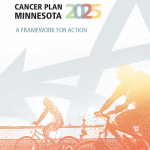Updated School E-cigarette Toolkit
Addressing Student Use of E-cigarettes and other Vaping Products
 We recently updated our School E-cigarette Toolkit, which provides tools and resources for Minnesota school staff, including administrators, educators, teachers and health services staff, who are working to address the use of e-cigarettes and other vaping products in schools. It outlines opportunities for action that can be taken by various school staff, along with resources and tools to help. Get the toolkit.
We recently updated our School E-cigarette Toolkit, which provides tools and resources for Minnesota school staff, including administrators, educators, teachers and health services staff, who are working to address the use of e-cigarettes and other vaping products in schools. It outlines opportunities for action that can be taken by various school staff, along with resources and tools to help. Get the toolkit.
New Resources in This Toolkit
Alternative Measures for Addressing Student Tobacco Use in Schools
School policies regulating the use and possession of tobacco products, including e-cigarettes and other vaping products like JUUL, often contain punitive measures for student violations. This document provides information and sample language for alternative penalties to suspension and expulsion, which are often used to enforce a school commercial Tobacco-Free Policy. Read More: Addressing Student Tobacco Use in Schools (PDF)
Free FDA “The Real Cost” E-Cigarette Prevention Posters and More
The U.S. Food and Drug Administration (FDA) is distributing youth e-cigarette prevention posters to every high school in the United States. These posters were developed as part of FDA’s “The Real Cost” E-Cigarette Prevention Campaign, which launched in September 2018, and aim to educate teens on the dangers of e-cigarette use. The posters are intended to be displayed in high school bathrooms—a location where teens are often faced with the decision to use e-cigarettes – and deliver snarky, hard-hitting messages such as:
- “Strangely enough, some students come in here to put crap into their bodies. Vapes can contain some of the same cancer-causing chemicals found in cigarettes.”
- “Some of the grossest things in this bathroom are in that vape. Vaping can expose your lungs to acrolein, which can cause irreversible damage.”
In addition to providing the “The Real Cost” campaign posters to high schools, FDA has developed two new posters for use by doctors, youth groups, churches, state and local public health agencies, and others who may find these resources helpful in educating youth on the dangers of e-cigarette use. The posters, which also address the potential health consequences of e-cigarette use, are available for download or for print via the CTP Exchange Lab. Download and Order Posters
 Youth Quit Tobacco Resources
Youth Quit Tobacco Resources
Truth Initiative® E-cigarette Quit Programs
The Truth Initiative® recently announced a new e-cigarette quit program. This free text message program was created with input from teens, college students and young adults who have attempted to, or successfully, quit e-cigarettes. It’s tailored by age group to give teens and young adults appropriate recommendations about quitting. The program also serves as a resource for parents looking to help their children who now vape.
To access the new e-cigarette quit program, users can text “QUIT” to (202) 804-9884. Users can also enroll in This is Quitting or BecomeAnEX®, free digital quit programs from Truth Initiative that integrate the text program. Find more resources for Quitting Tobacco.
Know the Risks of Youth E-cigarette Use
E-cigarettes are battery-powered devices that allow users to inhale, or vape, aerosolized liquid (e-juice). E-cigarettes, “vapes”, vape or hookah pens, e-pipes, and other vaping products, like JUUL, recently surpassed conventional cigarettes as the most commonly used tobacco product among youth so it is critical that public health officials and the general public understand the potential risks of using them.
These products contain nicotine, which is highly addictive and has negative implications for learning, memory, attention, and future addiction to tobacco and other substances. Learn more about E-cigarettes and Other Vaping Products.
Tobacco products contain nicotine, which is highly addictive and can harm brain development as teens grow. Rural youth are at higher risk for harm, because they tend to begin using tobacco products at a younger age and use tobacco products more frequently. Read more
Teen Tobacco Use in Rural Minnesota
Rural teens start earlier, use more often, use smokeless
 The tobacco use landscape in the United States and Minnesota is evolving. E-cigarettes are rapidly increasing in popularity, especially among youth. However, products like cigarettes and smokeless tobacco continue to have a stronger hold in rural areas due to decades of targeted marketing by the tobacco industry, which integrated tobacco use into rural culture.
The tobacco use landscape in the United States and Minnesota is evolving. E-cigarettes are rapidly increasing in popularity, especially among youth. However, products like cigarettes and smokeless tobacco continue to have a stronger hold in rural areas due to decades of targeted marketing by the tobacco industry, which integrated tobacco use into rural culture.
Tobacco products contain nicotine, which is highly addictive and can harm brain development as teens grow. Rural youth are at higher risk for harm, because they tend to begin using tobacco products at a younger age and use tobacco products more frequently. Read more.
Menthol-Flavored Tobacco Products
Implementing Community-driven Approaches to Menthol Tobacco Prevention in Minnesota’s Metro African American Communities
Menthol tobacco use is particularly common in the African American community. Nearly nine in ten African American smokers age 12 and older use menthol. In 2015, the Minnesota Department of Health awarded a two-year grant to Hennepin County, Saint Paul-Ramsey, Bloomington-Edina-Richfield, and Minneapolis Health Departments to better understand menthol tobacco use in the African American community. Local public health formed a close partnership with the African American Leadership Forum to engage the African American community on menthol through assessment and education.
A new case study on this work describes successes, challenges, and lessons learned during the 2015 Menthol Cigarette Intervention Grant with a focus on the role of public health in the menthol policy adoption process. The purpose of this case study is to inform other local and state health departments who are working on menthol so they can learn from these efforts and more effectively implement a community-driven approach to menthol tobacco prevention in their own communities. Learn more.


